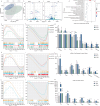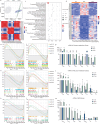Multi-strain probiotics attenuate carbohydrate-lipid metabolic dysregulation in type 2 diabetic rats via gut-liver axis modulation
- PMID: 40492727
- PMCID: PMC12282120
- DOI: 10.1128/msystems.00369-25
Multi-strain probiotics attenuate carbohydrate-lipid metabolic dysregulation in type 2 diabetic rats via gut-liver axis modulation
Abstract
Type 2 diabetes mellitus (T2DM) is a pervasive chronic metabolic disorder characterized by dysregulation of carbohydrate, protein, and lipid metabolism. The objective of this study was to elucidate the impact of multi-strain probiotic supplementation on the metabolism of carbohydrates and lipids and the interplay between the gut and liver in a T2DM rat model. A total of 32 rats were randomly assigned to four experimental groups: a control group, a T2DM model group, a low-dose probiotics group, and a high-dose probiotics group. The impact of probiotic intervention on glycemic and lipid profiles was evaluated, with a specific emphasis on the high-dose cohort. The treatment with multi-strain probiotics, consisting of three Lacticaseibacillus species and one Bifidobacterium species, resulted in a significant improvement in blood glucose and lipid profiles in T2DM rats, with the highest dosage demonstrating the most pronounced effects. Probiotic administration modulated gut microbiota composition and diversity, enriching potentially beneficial bacterial species and altering gut metabolic modules and carbohydrate-active enzyme profiles. Multi-omics analyses indicated that alterations in fecal short-chain fatty acids and serum bile acids may serve as pivotal mediators for crosstalk between hepatic and gut transcriptomic pathways. This study offers novel insights into the role of probiotics in managing T2DM via the gut-liver axis, emphasizing the potential of probiotic therapy in modulating key metabolic pathways.IMPORTANCEType 2 diabetes mellitus (T2DM) is a chronic metabolic disease characterized by hyperglycemia, caused by defects in insulin secretion, insulin action, or both. For individuals diagnosed with T2DM, managing diabetes-related complications is often the most challenging aspect. Exogenous probiotics have the potential to serve as a promising therapeutic strategy to improve diabetes-related symptoms. We conducted a 64-day animal experiment to investigate the effects of probiotics on T2DM-related metabolic disorders and dyslipidemia by feeding four mixed probiotics to T2DM rats. The results showed that probiotics exerted beneficial effects on glucose- and lipid-related homeostasis indices in diabetic rats to some extent and modulated the gut microbiota to manage T2DM via the gut-liver axis.
Keywords: bile acids; gut microbiota; probiotics; short-chain fatty acids; transcriptome; type 2 diabetes.
Conflict of interest statement
The authors declare no conflict of interest.
Figures







Similar articles
-
Study on the modulation of kidney and liver function of rats with diabetic nephropathy by Huidouba through metabolomics.J Ethnopharmacol. 2025 Jul 24;351:120136. doi: 10.1016/j.jep.2025.120136. Epub 2025 Jun 11. J Ethnopharmacol. 2025. PMID: 40513925
-
Effects of supplementation of live and heat-treated Bifidobacterium animalis subspecies lactis CECT 8145 on glycemic and insulinemic response, fecal microbiota, systemic biomarkers of inflammation, and white blood cell gene expression of adult dogs.J Anim Sci. 2024 Jan 3;102:skae291. doi: 10.1093/jas/skae291. J Anim Sci. 2024. PMID: 39320367
-
Synbiotics, prebiotics and probiotics for solid organ transplant recipients.Cochrane Database Syst Rev. 2022 Sep 20;9(9):CD014804. doi: 10.1002/14651858.CD014804.pub2. Cochrane Database Syst Rev. 2022. PMID: 36126902 Free PMC article.
-
Mulberry leaf improves type 2 diabetes in mice via gut microbiota-SCFAs-GPRs axis and AMPK signaling pathway.Phytomedicine. 2025 Sep;145:156970. doi: 10.1016/j.phymed.2025.156970. Epub 2025 Jun 10. Phytomedicine. 2025. PMID: 40527063
-
Probiotics for the prevention of pediatric antibiotic-associated diarrhea.Cochrane Database Syst Rev. 2015 Dec 22;(12):CD004827. doi: 10.1002/14651858.CD004827.pub4. Cochrane Database Syst Rev. 2015. Update in: Cochrane Database Syst Rev. 2019 Apr 30;4:CD004827. doi: 10.1002/14651858.CD004827.pub5. PMID: 26695080 Updated.
References
-
- Sun H, Saeedi P, Karuranga S, Pinkepank M, Ogurtsova K, Duncan BB, Stein C, Basit A, Chan JCN, Mbanya JC, Pavkov ME, Ramachandaran A, Wild SH, James S, Herman WH, Zhang P, Bommer C, Kuo S, Boyko EJ, Magliano DJ. 2022. IDF Diabetes Atlas: global, regional and country-level diabetes prevalence estimates for 2021 and projections for 2045. Diabetes Res Clin Pract 183:109119. doi: 10.1016/j.diabres.2021.109119 - DOI - PMC - PubMed
-
- Guo L, Xi Y, Jin W, Yuan H, Qin G, Chen S, Zhang L, Liu Y, Cheng X, Liu W, Yu D. 2024. A 5: 2 intermittent fasting meal replacement diet and glycemic control for adults with diabetes: the EARLY randomized clinical trial. JAMA Netw Open 7:e2416786. doi: 10.1001/jamanetworkopen.2024.16786 - DOI - PMC - PubMed
-
- Tamborlane WV, Barrientos-Pérez M, Fainberg U, Frimer-Larsen H, Hafez M, Hale PM, Jalaludin MY, Kovarenko M, Libman I, Lynch JL, Rao P, Shehadeh N, Turan S, Weghuber D, Barrett T, Ellipse Trial Investigators . 2019. Liraglutide in children and adolescents with type 2 diabetes. N Engl J Med 381:637–646. doi: 10.1056/NEJMoa1903822 - DOI - PubMed
MeSH terms
Substances
LinkOut - more resources
Full Text Sources
Medical

